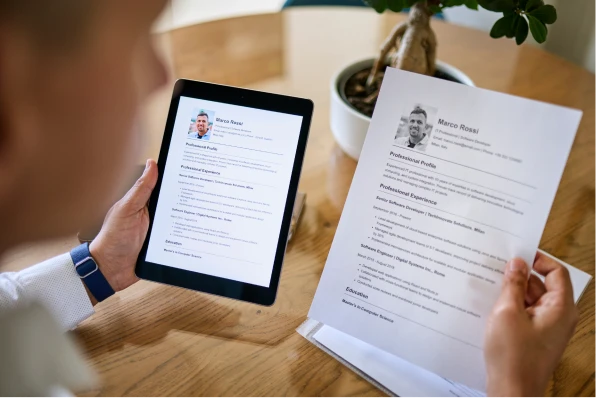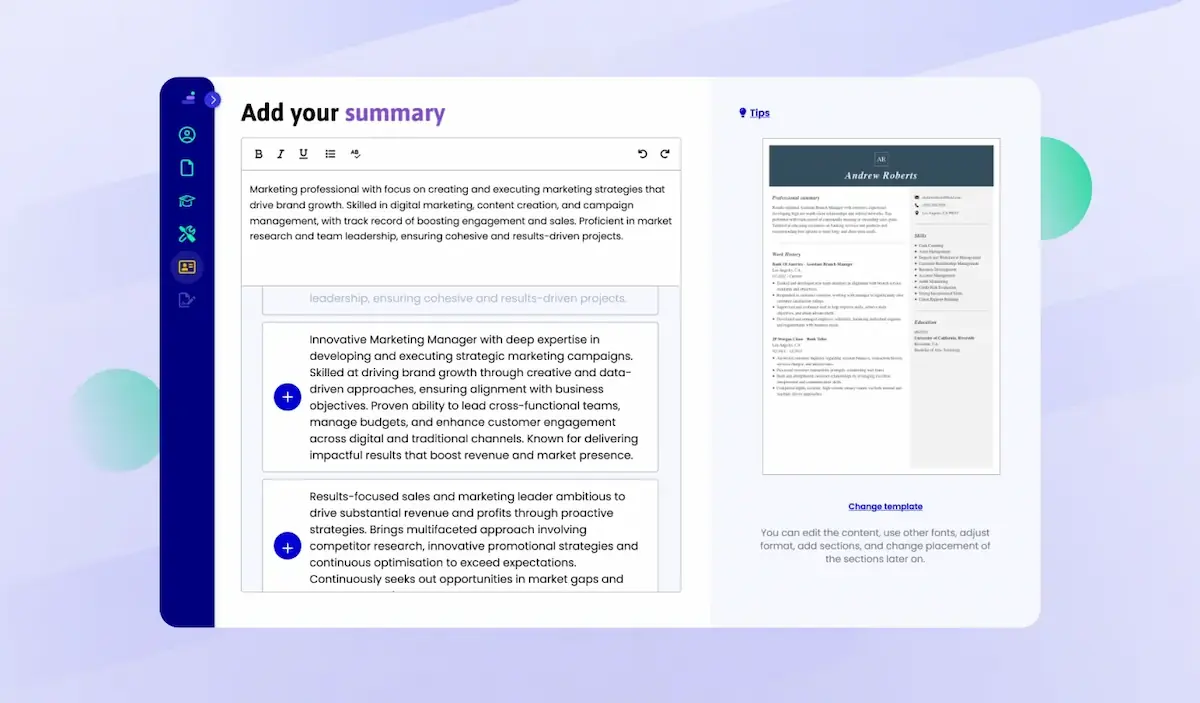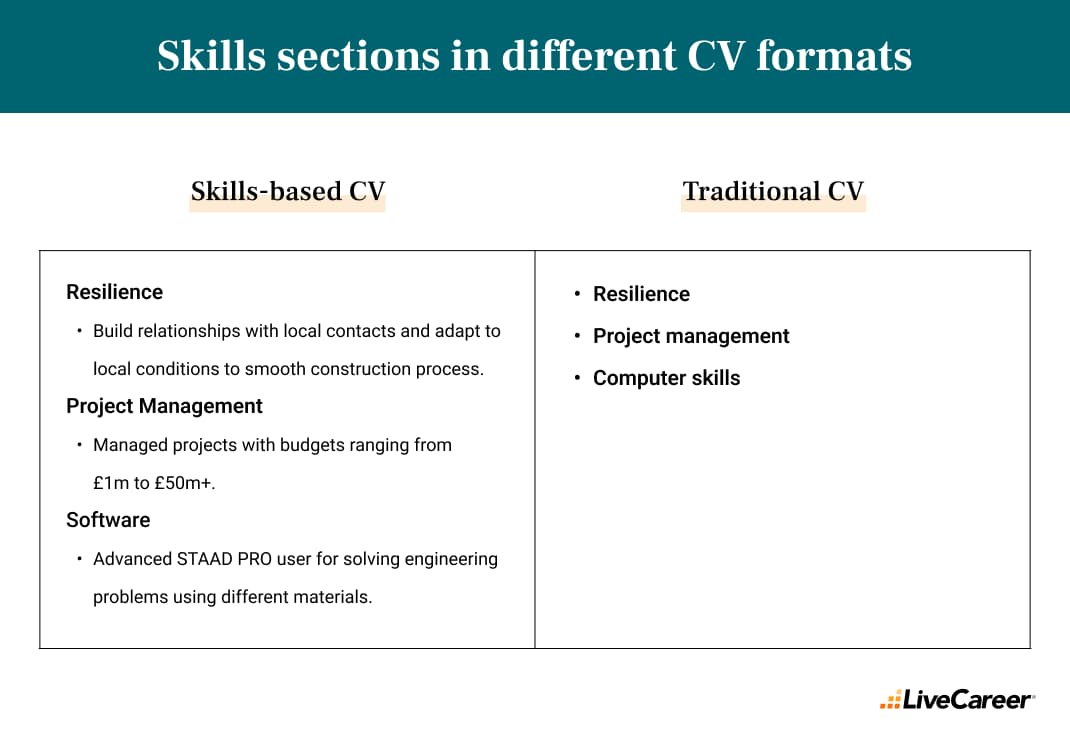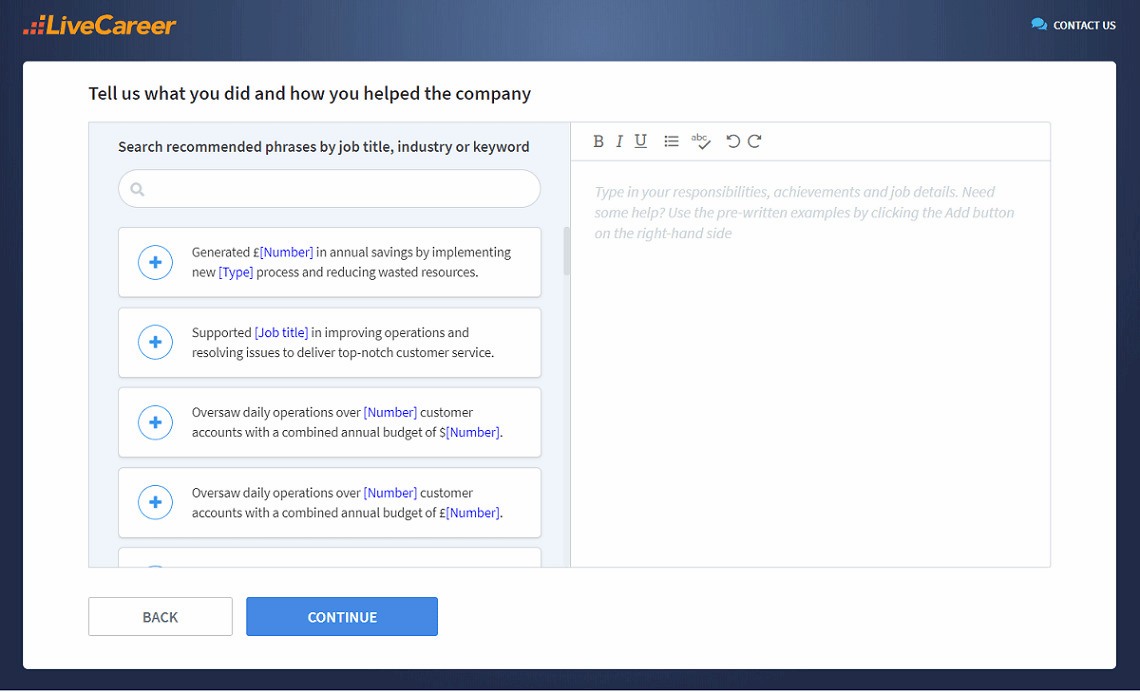
Care Assistant CV Example & Guide for 2026
Writing a good care assistant CV requires attention to detail. See how to write a CV for care assistant roles to prove your dedication and patience.
December 29, 2025
Last updated on 29 December, 2025

A skills based CV, or functional CV, is designed to put the emphasis on your key skills rather than a conventional chronological work history. It’s best suited for candidates without much experience in an industry who are looking to make a career change.
The format can also work very well for military personnel transitioning to the civilian workforce. A skills-based/functional CV can be very effective if used properly, but it’s a tough format to get right.
Even worse, recruiters tend to be very suspicious of them. The CV format doesn’t have the neatly laid out skimmable work history they crave, and it’s often used to hide gaps in a candidate’s employment history.
In this guide, we’re going to help you get those hiring managers onside. You’ll see how to create a skills-based CV template that will win over even the most hardened sceptic. Let’s get started.
Create an effective CV in minutes. Choose a professional CV template and fill in every section of your CV in a flash using ready-made content and expert tips.

We created the sample on the left using our builder. See other good CV examples like this one.
Seeking more help with your CV? Check similar guides:
Simon Caine
Ph: 0777 777 7777
Email: scaine_lc@gmail.com
Former lieutenant in the Royal Engineers with 10+ years of experience in military engineering and technical support. Seeking to make a transition to civil engineering projects specialising in transport and motorway applications. Skilled in adapting to local conditions and developing innovative solutions. Keen to assist Woods Corp as it continues its expansion in Central Asia.
Skills Summary
Resilience
Project Management
Software
Leadership
Work Experience
Lieutenant
The British Army, various postings including Iraq and Afghanistan
August 2010–Present
Education
BEng (Hons), September 2006–June2010
City University of London
Languages
For the majority of candidates, the preferred CV structure to follow is chronological. That’s the traditional CV structure that puts the emphasis on your professional experience. Here’s who does benefit from using a skills based CV format though.
Changing careers can be daunting. A lack of directly relevant experience can make writing a CV particularly challenging. But many candidates will have a wealth of transferable skills that more than make up for the lack of conventional experience. That’s where a skills based CV comes in. It leverages those skills to present the candidate as a solid prospect even without an applicable job history.
Likewise, making the move from a military career to civilian employment is also notoriously difficult. Summarising your career in the forces into a standard chronological CV can be like trying to fit a square peg into a round hole. But the skills that are gained from military experience are incredibly valuable. Again, this is where a skills-based CV comes to the fore, by showing off those abilities effectively.
Freelance and gig-based work has taken off in recent years but constantly moving from project to project can make it hard to fit your work history into a conventional CV. A skills-based CV, on the other hand, lets you focus on your core skills so it can work particularly well for candidates without vast experience.
If you don’t fall into these categories, stick to a chronological CV. But if you do, then a skills based CV could work well. Now let’s learn how to write one (and what makes a good CV).
Before you start writing, make sure you’re all set up to create a clear and readable CV layout. Creating an effective layout supports the reading process and allows the reader to find information easily and quickly. Here’s what you need to do.
Get your word processor settings right. Set your line spacing to single or 1.15 and set up page margins of one inch on each side. Make sure that you double space between each CV section too.
Then choose a neat and professional-looking CV font set to 11–12 pts in size. Cambria, Helvetica and Georgia are all safe choices.
And make sure you adhere to the best CV length. Your document shouldn’t be longer than two pages. Now that we’re ready to write your CV, we’ll give you a skills based CV template showing each section in the same order they appear on your CV.
Start off by including your personal details at the very top of the page. Include your full name in a font that’s 6–8 points larger than your body text, then write your email address, phone number, LinkedIn profile and social media handles if relevant. Don’t worry about including your home address, it’s not necessary.
Simon Caine
Ph: 0777 777 7777
Email: scaine_lc@gmail.com
Your personal statement or CV summary is a 3–5 line paragraph that introduces you as a candidate. Aim to grab the hiring manager’s attention and encourage them to keep reading. Think of it as a way of establishing who you are, what you have to offer as an employee and what your career goals are.
Before you start writing it, make a list of your professional skills and note your prior work experience. Then analyse the job description and note all of the skills and experience required for the role.
Next, check to see which of your own skills and experience match up with the job you’re targeting. Use 3–4 of these points combined with energy and enthusiasm for the role to craft a compelling personal statement.
Former lieutenant in the Royal Engineers with 10+ years of experience in military engineering and technical support. Seeking to make a transition to civil engineering projects specialising in transport and motorway applications. Skilled in adapting to local conditions and developing innovative solutions. Keen to assist Woods Corp as it continues its expansion in Central Asia.
A strong CV summary will convince the recruiter you’re the perfect candidate. Save time and choose a ready-made personal statement written by career experts and adjust it to your needs in the LiveCareer CV builder.

For a chronological CV the most important section is your work history. For a skills-based or functional CV template it’s your skills summary. This section is where the format gets its name from and it has to be polished to perfection. Here’s how to go about it.

Create a master list of all the CV skills you have. Here’s a reminder of some of the main types of skills to help get you started.
Then go back to the job advert and make a note of all the skills it requires. Also research the role and note any general skills that would be applicable. Now select 3–5 of your own skills that match the job requirements and use those to write your job description.
Each skill should be used as a subheading, then under each subheading you should write 2–4 bullet points where you use your experience and achievements to demonstrate how you’ve mastered that skill.
And much as you would with a CV work experience section, make sure you structure each bullet point to have maximum impact. Start each one off with a CV action verb to make it pop and structure them using accomplishment statements. It’s important not to just say what you did, but prove how well you did it.
Resilience
Project Management
Software
Leadership
Including your work history is still essential, even in a skills based CV. The difference is that this section will be much shorter than in standard chronological format. So include the same basic information about each role, your title, the name of the employer and the dates you worked there. And optionally, you can include up to two bullet points for each entry if your experience is particularly relevant.
Work Experience
Lieutenant
The British Army, various postings including Iraq and Afghanistan
August 2010–Present
Often overlooked, but always necessary, it’s essential to include an education section in your skills-based CV. For university graduates include the name of the degree you attained, the university you attended and your dates of study. Include an expected graduation date if you’re still studying and only include honours if they’re a first or a 2:1.
For school-leavers include your A-levels, naming each subject studied, along with the name of the school and your dates of study. It isn’t necessary to include your grades unless the job advert says so, but do highlight them if they’re particularly good. A full set of top marks is impressive in anyone’s book.
For candidates who’ve just graduated or are still studying you can put your education section before your work experience and add some additional detail. This could include impressive academic achievements or specific modules that highlight relevant skills and experience.
BEng (Hons), September 2006–June2010
City University of London
To give your skills based CV even more impact, make use of extra sections. They’re not essential, but including them helps you to stand out and strengthens your position as a quality candidate.
Good choices for additional sections include languages, hobbies and interests, awards and projects. If it adds to value to your application then it’s worth including.
Languages
Even the best skills based CV example benefits from the addition of a cover letter to complement it. Your cover letter is the perfect opportunity to add in even more detail about your strengths as a potential employee. Here’s a brief summary of what to include in a cover letter.
Start by making sure your cover letter address is correctly formatted and throw in an impressive professional achievement into your cover letter opening. Then add more examples of your skills and achievements that match up with the job requirements. Next, explain why you want to work for this particular company and finish by including a call to action in your cover letter ending.
It’s worth repeating that a skills-based CV should only be used by a very limited number of candidates. Apart from being difficult to write, it can also be problematic for some older ATS software. That’s the automated system that scans your CV before it gets sent to a human recruiter. And if the ATS can’t read it, that means rejection. So we advise you to proceed with caution.
You don’t have to be a CV writing expert. In the LiveCareer CV builder you’ll find ready-made content for every industry and position, which you can then add with a single click.

Thanks for reading, if you’d like to know more about creating a functional CV template, let us know in the comments section, and we’ll be happy to help.
Our editorial team has reviewed this article for compliance with LiveCareer’s editorial guidelines. It’s to ensure that our expert advice and recommendations are consistent across all our career guides and align with current CV and cover letter writing standards and trends. We’re trusted by over 10 million job seekers, supporting them on their way to finding their dream job. Each article is preceded by research and scrutiny to ensure our content responds to current market trends and demand.
Category: CV Help
Crafting a job-winning CV is all about showcasing your unique skills and experiences. Start with a strong personal statement that highlights your career goals and achievements.
Try Our CV Builder Now